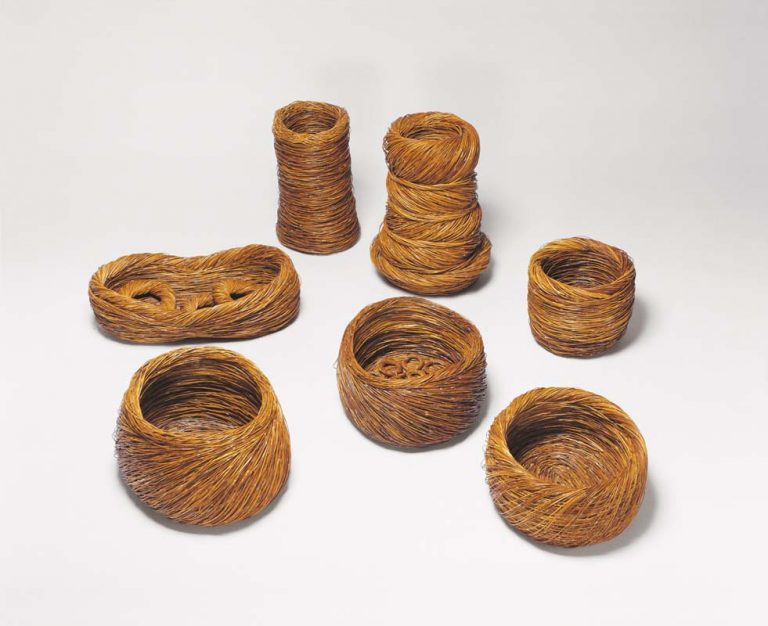We acknowledge the Traditional Owners of the land on which the Queensland Art Gallery | Gallery of Modern Art stands and recognise the creative contribution First Australians make to the art and culture of this country.

Shirley Macnamara / Indjalandji/Alyawarr / Australia b.1949 / Guutu (vessels) 2000 / Woven spinifex (Triodia pungens) with nylon thread and synthetic polymer fixative / Seven vessels: 19 x 23cm (diam.), 38 x 27cm (diam.), 33 x 18cm (diam.), 16 x 33cm (diam.), 17 x 31cm (diam.), 16 x 46 x 25cm (oval) and 22 x 34cm (diam.); 20 circlets ranging from .5 x 3cm (diam.) to 1 x 15cm (diam.) / Purchased 2001. Queensland Art Gallery Foundation Grant / Collection: Queensland Art Gallery | Gallery of Modern Art / © The artist
Shirley MacnamaraGuutu (vessels) 2000
Not Currently on Display
Shirley Macnamara uses natural and synthetic materials in her guutu (vessels), often combining spinifex from above the ground and ochre from below, bound together with shop-bought nylons and glues. She gathers the lateral roots of the spiny spinifex plant and twines the strands into dense, tough forms reminiscent of carved wooden vessels used in earlier times for gathering and storing bush foods.
For Macnamara, the inherent strength and flexibility of the spinifex stands as a metaphor for Aboriginal people who have struggled to survive, and reflects their deep cultural and family connections.
Shirley Macnamara strips the outer layer off the runner roots that connect the spinifex clumps. This reveals the colours inside which change according to the seasons — a paler yellow in times of rain, and red during dry and intense heat. She first discovered the colours when her horse trampled some spinifex, revealing the colour inside.
Shirley Macnamara runs a thriving cattle property with her son and his family near Mount Isa in western Queensland. She has close ties with Camooweal and the surrounding country through her mother’s Indjalandji people, and with Alyawarr lands, particularly Lake Nash, through her father.
Macnamara started painting in 1987, but began to experiment with weaving in 1992. She is well known for the guutu (vessels) she makes using combinations of synthetic and natural materials. In particular, she likes to work with spinifex (Triodia pungens), a tough, spikey native grass commonly found in the driest parts of Australia.
Spinifex’s long roots help keep the soil together so that the sand does not spread and create more desert. For Macnamara, spinifex embodies strength and utility, and she uses it to create tactile sculptures that reflect her surroundings, culture and history, as well as personal experiences and memories.
Discussion Questions
1. Compare Macnamara’s vessels with Sonja Carmichael’s Deranji Dabayil (Rocky place, healing waters): Baskets of Culture 2017. Consider form, structure and pattern.
Classroom Activities
Soak a mixture of cane and dried vines or grass stems in water to soften them. Using these materials, experiment with weaving a random vessel form. Twist and tuck the wet stems into each other, and pegs or twist ties to hold the shape until it dries and stiffens. Keep weaving until the form is complete.